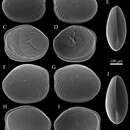pms
nòm ant ël fil


Polycopidae is a family of marine ostracods. Its members are related to animals in the suborder Halocypridina, but are sufficiently distinct to be placed in the sub-order Cladocopina. There is even some speculation that a separate order may be warranted.[1] The genera in the family differ from the other suborder, Halocypridina, in several features: the central adductor muscle scars are in a triangular (3 scars) or half-rosette (15 scars) pattern, they lack sixth and seventh limbs, and the maxilla (=fourth limb) has both an exopod and endopod (the maxilla in the Halocypridina lacks an exopod).[2][3][4][5]
The following genera are included:[6]
Polycopidae is a family of marine ostracods. Its members are related to animals in the suborder Halocypridina, but are sufficiently distinct to be placed in the sub-order Cladocopina. There is even some speculation that a separate order may be warranted. The genera in the family differ from the other suborder, Halocypridina, in several features: the central adductor muscle scars are in a triangular (3 scars) or half-rosette (15 scars) pattern, they lack sixth and seventh limbs, and the maxilla (=fourth limb) has both an exopod and endopod (the maxilla in the Halocypridina lacks an exopod).
The following genera are included:
Archypolycope Chavtur, 1981 Axelheibergella Briggs, 1997 †Discoidella Croneis & Gale, 1939 Eupolycope Chavtur, 1981 Hexopolycope Chavtur, 1981 Hyphalocope I. Karanovic & Brandão, 2012 Kliecope Tanaka, Tsukagoshi & Karanovic, 2014 Metapolycope Kornicker & van Morkhoven, 1976 Micropolycope Chavtur, 1981 †Nodopolycope Kozur, 1985 Orthopolycope Chavtur, 1981 Parapolycope Klie, 1936 Parapolycopissa Chavtur, 1981 Permopolycope Kozur, 1985 Polycope G. O. Sars, 1866 Polycopetta Chavtur, 1981 Polycopiella Chavtur, 1981 Polycopinna Chavtur, 1981 Polycopinoidea Hu & Tao, 2008 Polycopissa Chavtur, 1981 Polycopsis G. W. Mueller, 1894 Pontopolycope Chavtur, 1981 Pseudopolycope Chavtur, 1981Polycopidae is een familie van kreeftachtigen uit de klasse van de Ostracoda (mosselkreeftjes).
Polycopidae is een familie van kreeftachtigen uit de klasse van de Ostracoda (mosselkreeftjes).
Polycopidae er den eneste nålevende av ialt to familier i overfamilien Polycopoidea, som igjen er den eneste undergruppen av underordenen Cladocopina - i ordenen Halocyprida av Myodocopa-muslingkreps, som er små krepsdyr. Derimot har familien også en søsterfamilie av utdødde arter, nemlig Quasipolycopidae (Jones, 1995).
Familien Polycopidae har 6 slekter og 14 arter. Det som kjennetegner denne underordenen er at den ikke har et synlig sjette par med bein, mens artene av den andre Halocyprida-underordenen, Halocypridina, har et slikt synlig sjette beinpar.
Som en del av Myodocopa-gruppen har Polycopidae-artene for øvrig mykt skall (carapax) på overkroppen (thorax) og lang ytter-gren (i stedet for lang inner-gren) på andre antenne-par. [1] Det særegne for Halocyprida er at antennen sitter på et feste som mangler den nebb-liknende utveksten (rostrum) som vi finner hos Myodocopida. [2] Dessuten er 5. og 7. ledd av underkroppen annerledes enn hos Myodocopida-individene. Individene er som regel rundt 1 mm lange.
Alle artene i familieen lever i saltvann. Det finnes mange planktoniske arter i denne gruppen, men mange lever nær bunnen. De pløyer seg igjennom bunnslammet og eter detritus og alger.
Taksonomien til muslingkrepsene er omstridt og baserer seg på studier av morfologi snarere enn genetikk. Det er generelt omstridt å fin-inndele organismer taksonomisk. En vanlig oppdeling anerkjenner muslingkreps som en av seks ulike klasser av krepsdyr. En moderne oppdatering av systematikken gis av Martin and Davis[3], som følgende oversikt følger ned til nivået orden, mens lavere nivåer i enkelte tilfeller følger Catalogue of Life: [4] - og i hovedregel WoRMS-databasen.[5]
Polycopidae er den eneste nålevende av ialt to familier i overfamilien Polycopoidea, som igjen er den eneste undergruppen av underordenen Cladocopina - i ordenen Halocyprida av Myodocopa-muslingkreps, som er små krepsdyr. Derimot har familien også en søsterfamilie av utdødde arter, nemlig Quasipolycopidae (Jones, 1995).
Familien Polycopidae har 6 slekter og 14 arter. Det som kjennetegner denne underordenen er at den ikke har et synlig sjette par med bein, mens artene av den andre Halocyprida-underordenen, Halocypridina, har et slikt synlig sjette beinpar.
Som en del av Myodocopa-gruppen har Polycopidae-artene for øvrig mykt skall (carapax) på overkroppen (thorax) og lang ytter-gren (i stedet for lang inner-gren) på andre antenne-par. Det særegne for Halocyprida er at antennen sitter på et feste som mangler den nebb-liknende utveksten (rostrum) som vi finner hos Myodocopida. Dessuten er 5. og 7. ledd av underkroppen annerledes enn hos Myodocopida-individene. Individene er som regel rundt 1 mm lange.
Alle artene i familieen lever i saltvann. Det finnes mange planktoniske arter i denne gruppen, men mange lever nær bunnen. De pløyer seg igjennom bunnslammet og eter detritus og alger.